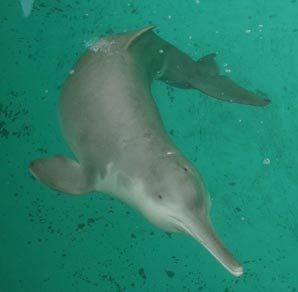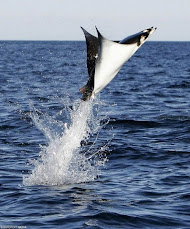





The Javan Rhinoceros (Sunda Rhinoceros to be more precise) or Lesser One-horned Rhinoceros (Rhinoceros sondaicus) is a member of the family Rhinocerotidae and one of five extant rhinoceroses. It belongs to the same genus as the Indian Rhinoceros, and has similar mosaicked skin which resembles armor, but at 3.1–3.2 m (10–10.5 feet) in length and 1.4–1.7 m (4.6–5.8 ft) in height, it is smaller than the Indian Rhinoceros, and is closer in size to the Black Rhinoceros. Its horn is usually less than 25 cm (10 inches), smaller than those of the other rhino species.
Once the most widespread of Asian rhinoceroses, the Javan Rhinoceros ranged from the islands of Indonesia, throughout Southeast Asia, and into India and China. The species is now critically endangered, with only two known populations in the wild, and none in zoos. It is possibly the rarest large mammal on earth.[5] A population of at least 40–50 live in Ujung Kulon National Park on the island of Java in Indonesia and a small population, estimated in 2007 to be no more than eight, survives in Cat Tien National Park in Vietnam. The decline of the Javan Rhinoceros is attributed to poaching, primarily for their horns, which are highly valued in traditional Chinese medicine, fetching as much as $30,000 per kilogram on the black market.[5] Loss of habitat, especially as the result of wars, such as the Vietnam War, in Southeast Asia, has also contributed to the species's decline and hindered recovery.[6] The remaining range is only within two nationally protected areas, but the rhinos are still at risk from poachers, disease and loss of genetic diversity leading to inbreeding depression.
The Javan Rhino can live approximately 30–45 years in the wild. It historically inhabited lowland rain forest, wet grasslands and large floodplains. The Javan Rhino is mostly solitary, except for courtship and child-rearing, though groups may occasionally congregate near wallows and salt licks. Aside from humans, adults have no predators in their range. The Javan Rhino usually avoids humans, but will attack when it feels threatened. Scientists and conservationists rarely study the animals directly due to their extreme rarity and the danger of interfering with such an endangered species. Researchers rely on camera traps and fecal samples to gauge health and behavior. Consequently, the Javan Rhino is the least studied of all rhino species.
Distribution and habitat
Even the most optimistic estimate suggests there are fewer than 100 Javan Rhinos in the wild. They are considered possibly the most endangered of all large mammals; although there are more Sumatran Rhinos, their range is not as protected as that of the Javan Rhinos, and some conservationists consider them to be at greater risk. The Javan Rhinoceros is only known to survive in two places, the Ujung Kulon National Park on the western tip of Java and the Cat Tien National Park about 150 km (90 miles) north of Ho Chi Minh City.
The animal was once widespread from Assam and Bengal (where their range would have overlapped with both the Sumatran and Indian Rhino) eastward to Myanmar, Thailand, Cambodia, Laos, Vietnam, and southwards to the Malay Peninsula and the islands of Sumatra, Java and possibly Borneo. The Javan Rhino primarily inhabits dense lowland rain forests, tall grass and reed beds that are plentiful with rivers, large floodplains, or wet areas with many mud wallows. Although it historically preferred low-lying areas, the subspecies in Vietnam has been pushed onto much higher ground (up to 2,000 m or 6,561 ft), probably because of human encroachment and poaching.
The range of the Javan Rhinoceros has been shrinking for at least 3,000 years. Starting around 1000 BC, the northern range of the rhinoceros extended into China, but began moving southward at roughly 0.5 km (0.3 mile) per year, as human settlements increased in the region. It likely became locally extinct in India in the first decade of the 20th century. The Javan Rhino was hunted to extinction on the Malaysian peninsula by 1932. By the end of the Vietnam War, the Vietnamese Rhinoceros was believed extinct across all of mainland Asia. Local hunters and woodcutters in Cambodia claim to have seen Javan Rhinos in the Cardamom Mountains, but surveys of the area have failed to find any evidence of them. A population may have existed on the island of Borneo as well, though these specimens could have been the Sumatran Rhinoceros, a small population of which still lives there.
Behavior
The Javan Rhinoceros is a solitary animal with the exception of breeding pairs and mothers with calves. They will sometimes congregate in small groups at salt licks and mud wallows. Wallowing in mud is a common behavior for all rhinos; the activity allows them to maintain a cool body temperature and helps prevent disease and parasite infestation. The Javan Rhinoceros does not generally dig its own mud wallows, preferring to use other animals' wallows or naturally occurring pits, which it will use its horns to enlarge. Salt licks are also very important because of the essential nutrients the rhino receives from the salt. Males's home ranges are larger at 12–20 km² (5–8 miles²) compared to the females's which are around 3–14 km² (1–5 mi²). Males's territories overlap each other less than those of females. It is not known if there are territorial fights.
Males mark their territory with dung piles and by urine spraying. Scrapes made by the feet in the ground and twisted saplings also seem to be used for communication. Members of other rhino species have a peculiar habit of defecating in massive rhino dung piles and then scraping their back feet in the dung. The Sumatran and Javan Rhinoceros, while defecating in piles, do not engage in the scraping. This adaptation in behavior is thought to be ecological; in the wet forests of Java and Sumatra, the method may not be useful for spreading odors.
The Javan Rhino is much less vocal than the Sumatran; very few Javan Rhino vocalizations have ever been recorded. Adult Javan Rhinos have no known predators other than humans. The species, particularly in Vietnam, is skittish and retreats into dense forests whenever humans are near. Though a valuable trait from a survival standpoint, it has made the rhinos difficult to study. Nevertheless, when humans approach too closely, the Javan Rhino becomes aggressive and will attack, stabbing with the incisors of its lower jaw while thrusting upward with its head.Its comparatively anti-social behavior may be a recent adaptation to population stresses; historical evidence suggests that, like other rhinos, the species was once more gregarious.
Diet
The Javan Rhinoceros is herbivorous and eats diverse plant species, especially their shoots, twigs, young foliage and fallen fruit. Most of the plants favored by the species grow in sunny areas: in forest clearings, shrubland and other vegetation types with no large trees. The rhino knocks down saplings to reach its food and grabs it with its prehensile upper lip. It is the most adaptable feeder of all the rhino species. Currently it is a pure browser but probably once both browsed and grazed in its historical range. The rhino eats an estimated 50 kg (110 lb) of food daily. Like the Sumatran Rhino, it needs salt in its diet. The salt licks common in its historical range do not exist in Ujung Kulon, but the rhinos there have been observed drinking seawater, likely for the same nutritional need.
Reproduction
The sexual habits of the Javan Rhinoceros are difficult to study as the species is rarely observed directly and no zoos have specimens. Females reach sexual maturity at 3–4 years of age while the males are sexually mature at 6. Gestation is estimated to occur over a period around 16–19 months. The birth interval for this species is 4–5 years and the calf is weaned at around 2 years. The other four species of rhino all have similar mating behaviors and the presumption is that the Javan Rhino follows suit.



































